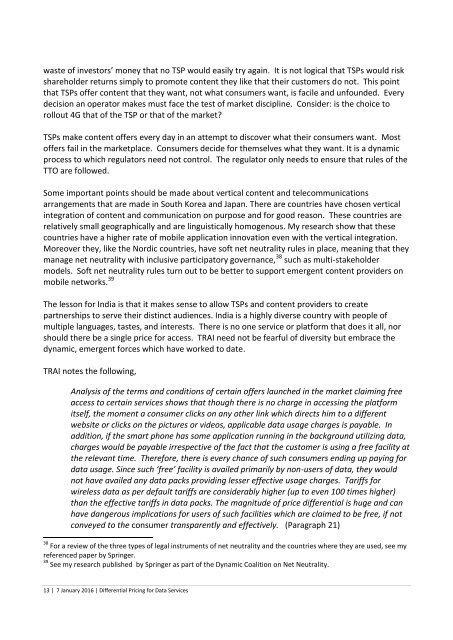Layton
Layton
Layton
Create successful ePaper yourself
Turn your PDF publications into a flip-book with our unique Google optimized e-Paper software.
waste of investors’ money that no TSP would easily try again. It is not logical that TSPs would risk<br />
shareholder returns simply to promote content they like that their customers do not. This point<br />
that TSPs offer content that they want, not what consumers want, is facile and unfounded. Every<br />
decision an operator makes must face the test of market discipline. Consider: is the choice to<br />
rollout 4G that of the TSP or that of the market?<br />
TSPs make content offers every day in an attempt to discover what their consumers want. Most<br />
offers fail in the marketplace. Consumers decide for themselves what they want. It is a dynamic<br />
process to which regulators need not control. The regulator only needs to ensure that rules of the<br />
TTO are followed.<br />
Some important points should be made about vertical content and telecommunications<br />
arrangements that are made in South Korea and Japan. There are countries have chosen vertical<br />
integration of content and communication on purpose and for good reason. These countries are<br />
relatively small geographically and are linguistically homogenous. My research show that these<br />
countries have a higher rate of mobile application innovation even with the vertical integration.<br />
Moreover they, like the Nordic countries, have soft net neutrality rules in place, meaning that they<br />
manage net neutrality with inclusive participatory governance, 38 such as multi-stakeholder<br />
models. Soft net neutrality rules turn out to be better to support emergent content providers on<br />
mobile networks. 39<br />
The lesson for India is that it makes sense to allow TSPs and content providers to create<br />
partnerships to serve their distinct audiences. India is a highly diverse country with people of<br />
multiple languages, tastes, and interests. There is no one service or platform that does it all, nor<br />
should there be a single price for access. TRAI need not be fearful of diversity but embrace the<br />
dynamic, emergent forces which have worked to date.<br />
TRAI notes the following,<br />
Analysis of the terms and conditions of certain offers launched in the market claiming free<br />
access to certain services shows that though there is no charge in accessing the platform<br />
itself, the moment a consumer clicks on any other link which directs him to a different<br />
website or clicks on the pictures or videos, applicable data usage charges is payable. In<br />
addition, if the smart phone has some application running in the background utilizing data,<br />
charges would be payable irrespective of the fact that the customer is using a free facility at<br />
the relevant time. Therefore, there is every chance of such consumers ending up paying for<br />
data usage. Since such ‘free’ facility is availed primarily by non-users of data, they would<br />
not have availed any data packs providing lesser effective usage charges. Tariffs for<br />
wireless data as per default tariffs are considerably higher (up to even 100 times higher)<br />
than the effective tariffs in data packs. The magnitude of price differential is huge and can<br />
have dangerous implications for users of such facilities which are claimed to be free, if not<br />
conveyed to the consumer transparently and effectively. (Paragraph 21)<br />
38 For a review of the three types of legal instruments of net neutrality and the countries where they are used, see my<br />
referenced paper by Springer.<br />
39 See my research published by Springer as part of the Dynamic Coalition on Net Neutrality.<br />
13 | 7 January 2016 | Differential Pricing for Data Services


